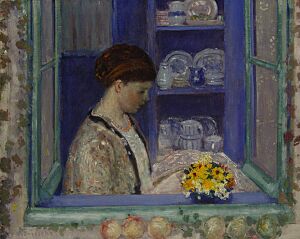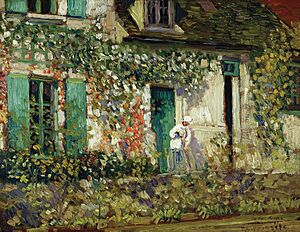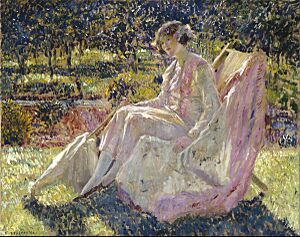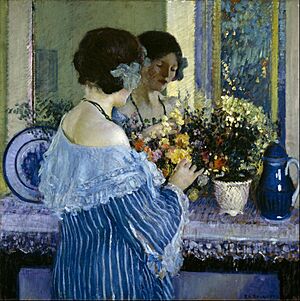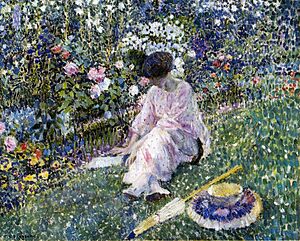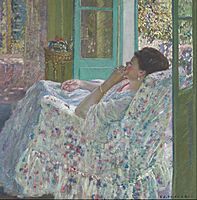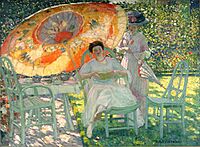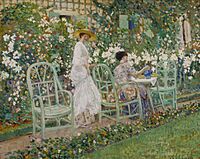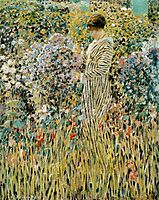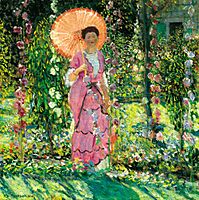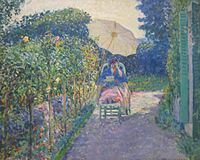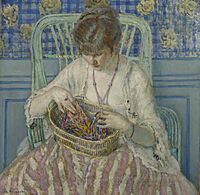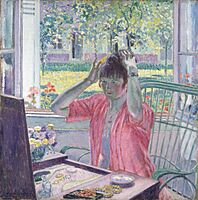Frederick Carl Frieseke facts for kids
Quick facts for kids
Frederick Carl Frieseke
|
|
|---|---|

Self-Portrait, 1901
|
|
| Born | April 7, 1874 |
| Died | August 24, 1939 (aged 65) Le Mesnil-sur-Blangy, Normandy, France
|
| Nationality | American |
| Known for | Painting |
| Movement | Impressionism/19th century Academic painting |
| Awards | 1904, silver medal, Louisiana Purchase Exposition • 1904, gold medal, Munich Exposition • 1908, Clark Prize, Corcoran Gallery of Art • 1913, Temple Gold Medal, Pennsylvania Academy of the Fine Arts • 1915, Grand Prize, Panama–Pacific International Exposition • 1920, two gold medals and the popular prize, Art Institute of Chicago • 1920, Chevalier of the French Legion of Honour |
| Elected | 1912, Associate, National Academy of Design • 1914, Academician, National Academy of Design |
Frederick Carl Frieseke (born April 7, 1874 – died August 24, 1939) was an American Impressionist painter. He spent most of his life living in France. He was an important artist in the Giverny art colony. His paintings often showed the beautiful effects of sunlight.
Contents
Early Life and Artistic Beginnings
Frederick Carl Frieseke's family came from Germany. His grandparents moved to Owosso, Michigan in 1858. His father, Herman, started a brick business there. Frederick was born in Owosso in 1874. When he was six, his mother, Eva, passed away. Around 1881, his family moved to Jacksonville, Florida. The four years he spent in Florida made a lasting impression on him.
Unlike most boys, Frederick was very interested in art. His grandmother, Valetta Gould Graham, enjoyed painting. She encouraged his artistic talents. A visit to the World's Columbian Exposition in Chicago in 1893 also inspired him. It made him want to become an artist.
Learning to Paint
In 1893, Frieseke finished high school. He then began his art training. He studied at the School of the Art Institute of Chicago. His teachers included Frederick Warren Freer. In 1895, he moved to New York. He continued his art education at the Art Students League of New York in 1897.
He worked as an illustrator to earn money. He sold cartoons to newspapers like The New York Times. He also drew for magazines such as Puck. In 1898, he moved to France. He stayed there for most of his life. He continued his studies at the Académie Julian in Paris. He also learned from James Abbott McNeill Whistler at Académie Carmen.
In the summer of 1898, Frieseke visited Holland. He sketched and painted with watercolors. He first planned to specialize in watercolors. But an instructor encouraged him to work with oil paints. Frieseke often said he was self-taught. He felt he learned more from studying other artists' work.
Life and Artwork in France
Starting in 1899, Frieseke began showing his art. He exhibited at the Salon of the Société Nationale des Beaux-Arts in Paris. At first, his paintings showed Whistler's influence. They had similar color tones. After 1900, his colors became lighter and brighter. This was more like the Impressionist style.
In 1905, he spent time in the Giverny art colony. In October of that year, he married Sarah Anne O'Bryan. She was known as Sadie. They spent every summer in Giverny from 1906 to 1919. Their house in Giverny was next to Claude Monet's home. Monet was a famous Impressionist painter. However, Frieseke did not become close friends with Monet. He said that no artist influenced him except perhaps Pierre-Auguste Renoir. Frieseke's paintings often show rounded figures. These figures look similar to Renoir's work.
The Friesekes' home and garden in Giverny often appeared in his paintings. His wife, Sadie, would often pose for him. His unique style quickly developed in Giverny. He became very influential among other artists there. Some of his paintings used "intense, almost arbitrary colors." This showed the influence of Post-Impressionist artists. An art writer called his style "Decorative Impressionism." This style mixed colorful patterns with sunlight effects.
Frieseke loved painting subjects in sunlight. He once said, "It is sunshine, flowers in sunshine; girls in sunshine." He wanted to reproduce it exactly as he saw it. But his sunlight often looked very special. One observer noted his light seemed "entirely artificial." It was a mix of blues, magentas, and greens.
In 1909, seventeen of Frieseke's paintings were shown at the prestigious Venice Biennale. Many American artists in Giverny were influenced by him. These artists often shared his Midwestern background. They had also started their art studies in Chicago.
Frederick and Sadie's only child, Frances, was born in 1914. In 1920, the family moved to a farm in Le Mesnil-sur-Blangy, Normandy. During this time, his art focused on female figures. He used darker colors and fewer surface patterns. He also showed an interest in chiaroscuro, which is the use of strong contrasts between light and dark.
In 1923, he helped start a new art group called the Salon des Tuileries. He began painting with watercolors again. This was especially true during his trips to Nice in winter. He also painted watercolors during a visit to Switzerland. Frieseke was very well-known during his career. He died at his home in Normandy on August 24, 1939.
Awards and Recognition
Frederick Carl Frieseke won many awards. In 1904, he received a silver medal in St. Louis. He also won a gold medal in Munich. He earned the William A. Clark Prize in 1908. In 1913, he received the Temple Gold Medal.
One of his biggest honors was the Grand Prize. He won it at the Panama–Pacific International Exposition in San Francisco in 1915. His painting Summer was among his entries. It is now at the Metropolitan Museum of Art. The New York Times praised his work in 1915. They said his paintings showed great design, color, and style. They also noted his amazing understanding of outdoor light.
In 1920, he received two gold medals from the Art Institute of Chicago. He also won the popular prize, chosen by artists and the public. He was elected an Associate of the National Academy of Design in 1912. He became an Academician in 1914. In 1920, he was honored as a Chevalier of the French Legion of Honour. This was a rare award for an American painter.
Where to See His Art
Frederick Carl Frieseke's paintings are in many major art collections. Here are some of the places where you can see his work:
- Addison Gallery of American Art, Andover, Massachusetts
- Art Institute of Chicago
- Brooklyn Museum, New York City
- Corcoran Gallery of Art, Washington D.C.
- Detroit Institute of Arts
- Indianapolis Museum of Art
- Los Angeles County Museum of Art
- Metropolitan Museum of Art, New York City
- Minneapolis Institute of Arts
- Musée des Impressionnismes, Giverny
- Museum of Fine Arts, Boston
- National Gallery of Art, Washington D.C.
- Pennsylvania Academy of the Fine Arts, Philadelphia
- Philadelphia Museum of Art
- Saint Louis Art Museum, Saint Louis, Missouri
- Smithsonian American Art Museum, Washington D.C.
- Thyssen-Bornemisza Museum, Madrid
- Virginia Museum of Fine Arts, Richmond
Gallery
- Paintings by Frederick Carl Frieseke



